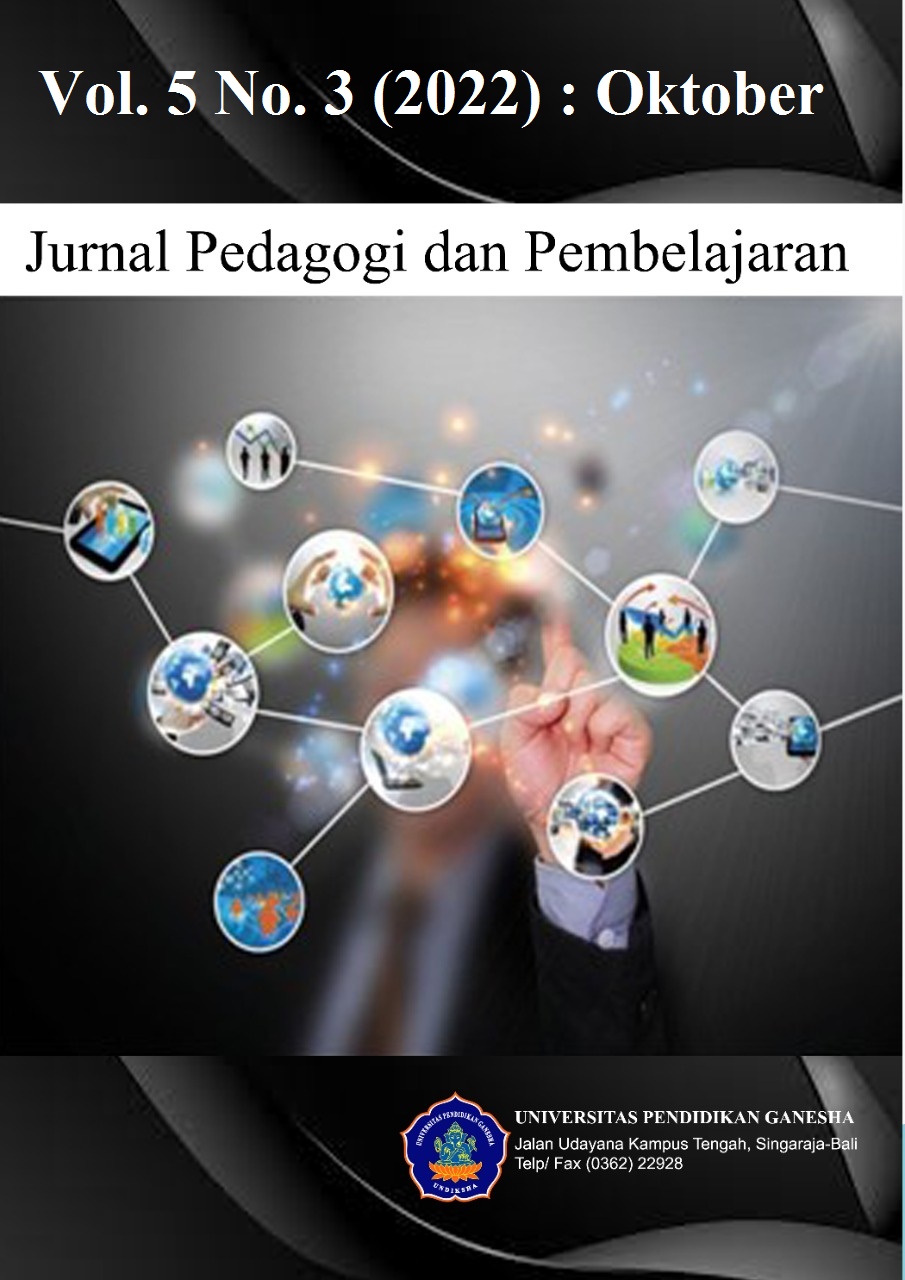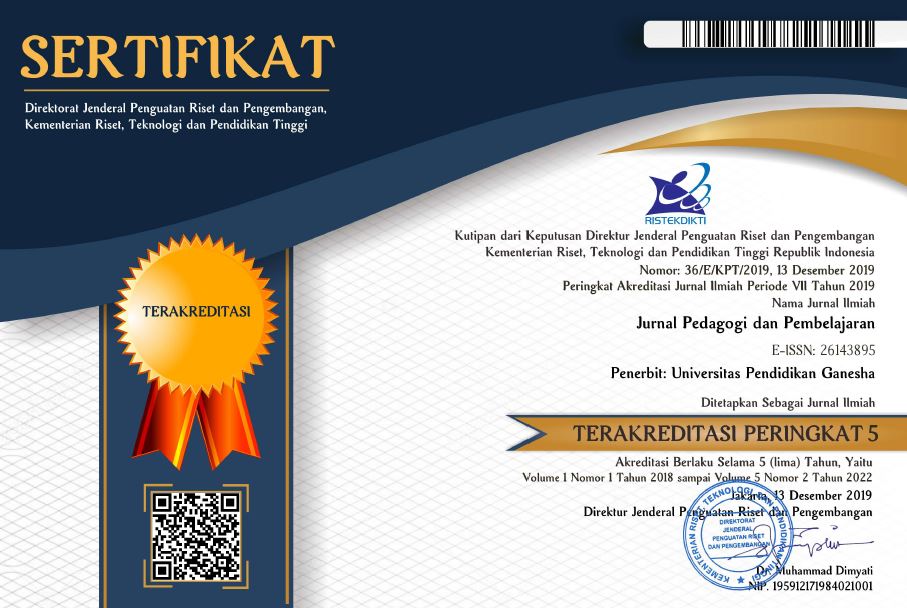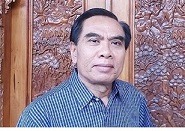Museum Virtual Tour Development Using 3D Vista as a History Learning Source
DOI:
https://doi.org/10.23887/jp2.v5i3.51494Kata Kunci:
Virtual Tour Museum, Sriwijaya, 3D VistaAbstrak
Visits to museums are also a means of learning that arouses curiosity and provides a different nuance in learning. The problem today is that distance and time are not possible if the teacher brings students to the location of the museum. An alternative solution to these problems is to use technology. This study aims to develop a virtual tour learning tool at the Sriwijaya museum by using the 3D Vista application as a source for learning history. The stages of this research adapt to the product development research model of Alessi and Trollip, namely design, planning, and development. The device developed was validated by experts and tested on the subjects 30 student of class X at senior high school. The trial design in this study used a one group pretest and posttest design. Data collection techniques include interviews, tests, and questionnaires. The data analysis technique used analysis of the results of interviews, tests, and questionnaires. The result of this study are, 1) the developed learning tools have been tested for validity after going through validation with 4 experts; 2) virtual tour museum learning resources have been tested for practicality with a practicality percentage of 87.87%; and 3) the effectiveness of the device consisting of student activities in the learning process obtained an N-Gain of 5.57 with a medium category. The conclusion of this study is that the learning tools developed were tested to be valid, practical, and effective.
Referensi
Alessi, S. M., & Trollip, S. R. (2001). Multimedia for learning: Methods and development. Allyn & Bacon.
Amin, I., Yousaf, A., Walia, S., & Bashir, M. (2021). What Shapes E-Learning Effectiveness among Tourism Education Students? An Empirical Assessment during COVID19. Journal of Hospitality, Leisure, Sport and Tourism Education, xxxx, 100337. https://doi.org/10.1016/j.jhlste.2021.100337. DOI: https://doi.org/10.1016/j.jhlste.2021.100337
Andarwati, M. (2019). Pembelajaran Sejarah Kontekstual, Kreatif, Menyenangkan di Kelas Dengan “Power Director” bagi Generasi Z. Jurnal Pendidikan Sejarah Indonesia, 2(1), 64–81. https://doi.org/10.17977/um033v2i12019p064. DOI: https://doi.org/10.17977/um033v2i12019p064
Azizah, U., Djono, D., & Musadad, A. A. (2020). Developing Digital Book Based on Lafran Pane’ Thought for Increasing State Defend Attitude of Students. Yupa: Historical Studies Journal, 4(1), 29–39. https://doi.org/10.30872/yupa.v4i1.235. DOI: https://doi.org/10.30872/yupa.v4i1.235
Barbieri, L., Bruno, F., & Muzzupappa, M. (2017). Virtual museum system evaluation through user studies. Journal of Cultural Heritage, 26, 101–108. https://doi.org/10.1016/j.culher.2017.02.005. DOI: https://doi.org/10.1016/j.culher.2017.02.005
Bydłosz, J., Bieda, A., & Parzych, P. (2018). The implementation of spatial planning objects in a 3D cadastral model. ISPRS International Journal of Geo-Information, 7(4), 153. https://doi.org/10.3390/ijgi7040153. DOI: https://doi.org/10.3390/ijgi7040153
Carayannis, E. G., & Morawska-Jancelewicz, J. (2022). The Futures of Europe: Society 5.0 and Industry 5.0 as Driving Forces of Future Universities. Journal of the Knowledge Economy, 0123456789. https://doi.org/10.1007/s13132-021-00854-2. DOI: https://doi.org/10.1007/s13132-021-00854-2
Christa, M., & Roy, L. (2002). Digital Repatriation: Constructing a Culturally Responsive Virtual Museum Tour. Journal of Library and Information Science, 28(1), 14–18. https://jlis.glis.ntnu.edu.tw/ojs../index.php/jlis/article/viewFile/396/396.
Chust, P., Alberto, D. de A. M., Cerdan, A. P., García, J. C. R., Server, J.-V. B., Daviu, E. A., Llorente, C. V., & Andres, F. J. E. (2013). The Teaching-Learning Process in the Classroom Using Smartphones: Challenges and Opportunities. The International Journal of Technologies in Learning, 19(3). https://riunet.upv.es/bitstream/handle/10251/45746/R4 - The Teaching-Learning Process in the Classroom - Using Smartphones Challenges and Opportunities.pdf?sequence=4. DOI: https://doi.org/10.18848/2327-0144/CGP/v19i03/59008
de la Peña, D., Lizcano, D., & Martínez-Álvarez, I. (2021). Learning through play: Gamification model in university-level distance learning. Entertainment Computing, 39(March). https://doi.org/10.1016/j.entcom.2021.100430. DOI: https://doi.org/10.1016/j.entcom.2021.100430
Dopo, F. B., & Ismaniati, C. (2016). Persepsi guru tentang digital natives, sumber belajar digital dan motivasi memanfaatkan sumber belajar digital. Jurnal Inovasi Teknologi Pendidikan, 3(1), 13–24. https://doi.org/10.21831/tp.v3i1.8 280. DOI: https://doi.org/10.21831/tp.v3i1.8280
Huo, Y., Wong, D. F., Ni, L. M., Chao, L. S., & Zhang, J. (2020). Knowledge modeling via contextualized representations for LSTM-based personalized exercise recommendation. Information Sciences, 523, 266–278. https://doi.org/10.1016/j.ins.2020.03.014. DOI: https://doi.org/10.1016/j.ins.2020.03.014
Jung, T., Claudia, M., Lee, H., Chung, N., Jung, T., Claudia, M., Lee, H., & Chung, N. (2016). This is the authors ’ final version published in Information and Communication Technologies in Tourism 2016 The original publication is available at : Effects of Virtual Reality and Augmented Reality on Visitor Experiences in Museum Department of Food and. Information and Communication Technologies in Tourism 2016, 621–635. https://doi.org/10.1007/978-3-319-28231-2-45. DOI: https://doi.org/10.1007/978-3-319-28231-2_45
Kang, S., & Kim, Y. (2021). Examining the quality of mobile-assisted, video-making task outcomes: The role of proficiency, narrative ability, digital literacy, and motivation: SAGE Journals. https://doi.org/10.1177/13621688211047984. DOI: https://doi.org/10.1177/13621688211047984
Kersten, T. P., Tschirschwitz, F., & Deggim, S. (2017). Development of a virtual museum including a 4D presentation of building history in virtual reality. International Archives of the Photogrammetry, Remote Sensing and Spatial Information Sciences - ISPRS Archives, 42(2W3), 361–367. https://doi.org/10.5194/isprs-archives-XLII-2-W3-361-2017. DOI: https://doi.org/10.5194/isprs-archives-XLII-2-W3-361-2017
Lionar, U., & Mulyana, A. (2019). Nilai-Nilai Multikultural Dalam Pembelajaran Sejarah: Identifikasi Pada Silabus. IJSSE : Indonesian Journal of Social Science Education, 1(1), 11–25. https://doi.org/10.29300/ijsse.v1i1.1322. DOI: https://doi.org/10.29300/ijsse.v1i1.1322
Loaiza Carvajal, D. A., Morita, M. M., & Bilmes, G. M. (2020). Virtual museums. Captured reality and 3D modeling. Journal of Cultural Heritage, 45, 234–239. https://doi.org/10.1016/j.culher.2020.04.013. DOI: https://doi.org/10.1016/j.culher.2020.04.013
Miniawi, H. El, & Brenjekjy, A. (2015). Educational Technology, Potentials, Expectations and Challenges. Procedia - Social and Behavioral Sciences, 174, 1474–1480. https://doi.org/10.1016/j.sbspro.2015.01.777. DOI: https://doi.org/10.1016/j.sbspro.2015.01.777
Perdana, Y., Djono, D., & Ediyono, S. (2018). The Implementation of Multicultural Education in History Learning At SMAN 3 Surakarta. International Journal of Multicultural and Multireligious Understanding, 5(3), 11. https://doi.org/10.18415/ijmmu.v5i3.135. DOI: https://doi.org/10.18415/ijmmu.v5i3.135
Poesponegoro, M. D., & Notosusanto, N. (2010). Sejarah Nasional Indonesia II (ke-4). Balai Pustaka.
Rahmawati, Y., Dianhar, H., & Arifin, F. (2021). Analysing students’ spatial abilities in chemistry learning using 3d virtual representation. Education Sciences, 11(4). https://doi.org/10.3390/educsci11040185. DOI: https://doi.org/10.3390/educsci11040185
Ramirez, H. J. M. (2021). Facilitating Computer-Supported Collaborative Learning with Question-Asking Scripting Activity and its Effects on Students’ Conceptual Understanding and Critical Thinking in Science. International Journal of Innovation in Science and Mathematics Education, 29(1), 31–45. https://doi.org/10.30722/IJISME.29.01.003. DOI: https://doi.org/10.30722/IJISME.29.01.003
Rashid, A. H. A., Shukor, N. A., Tasir, Z., & Na, K. S. (2021). Teachers’ perceptions and readiness toward the implementation of virtual learning environment. International Journal of Evaluation and Research in Education, 10(1), 209–214. https://doi.org/10.11591/ijere.v10i1.21014. DOI: https://doi.org/10.11591/ijere.v10i1.21014
Setiawan, J., Aman, & Wulandari, T. (2020). Understanding Indonesian history, interest in learning history and national insight with nationalism attitude. International Journal of Evaluation and Research in Education, 9(2), 364–373. https://doi.org/10.11591/ijere.v9i2.20474. DOI: https://doi.org/10.11591/ijere.v9i2.20474
Sholeh, K. (2017). Prasasti Talang Tuo Peninggalan Kerajaan Sriwijaya Sebagai Materi Ajar Sejarah Indonesia Di Sekolah Menengah Atas. Jurnal HISTORIA, 5(2). https://doi.org/10.24127/hj.v5i2.946. DOI: https://doi.org/10.24127/hj.v5i2.946
Smeda, N., Dakich, E., & Sharda, N. (2014). The effectiveness of digital storytelling in the classrooms: a comprehensive study. Smart Learning Environments, 1(1), 1–21. https://doi.org/10.1186/s40561-014-0006-3. DOI: https://doi.org/10.1186/s40561-014-0006-3
Styliani, S., Fotis, L., Kostas, K., & Petros, P. (2009). Virtual museums, a survey and some issues for consideration. Journal of Cultural Heritage, 10(4), 520–528. https://doi.org/10.1016/j.culher.2009.03.003. DOI: https://doi.org/10.1016/j.culher.2009.03.003
Suh, A., & Prophet, J. (2018). The state of immersive technology research: A literature analysis. Computers in Human Behavior, 86, 77–90. https://doi.org/10.1016/j.chb.2018.04.019. DOI: https://doi.org/10.1016/j.chb.2018.04.019
Supriadi, S. (2017). Pemanfaatan Sumber Belajar Dalam Proses Pembelajaran. Lantanida Journal, 3(2), 127. https://doi.org/10.22373/lj.v3i2.1654. DOI: https://doi.org/10.22373/lj.v3i2.1654
Suryani, N. (2018). Utilization of digital media to improve the quality and attractiveness of the teaching of history. The 2nd International Conference On Teacher Training and Education, 2(1), 131–144. https://jurnal.uns.ac.id/ictte/article/view/8164.
Tauresia, A., Harun, H., Putranta, H., Mailool, J., & Cahyo, H. (2020). The Effects of MANSA Historical Board Game toward the Students’ Creativity and Learning Outcomes on Historical Subjects. European Journal of Educational Research, 9(4), 1689–1700. https://doi.org/10.12973/eu-jer.9.4.1689. DOI: https://doi.org/10.12973/eu-jer.9.4.1689
Tjahjawulan, I., & Sabana, S. (2015). Panoramic Virtual Museum: Representation or Simulation. International Journal of Innovation, Management and Technology, 6(1), 40. http://www.ijimt.org/vol6/571-H028.pdf DOI: https://doi.org/10.7763/IJIMT.2015.V6.571
Wibowo, T. U. S. H., Maryuni, Y., Nurhasanah, A., & Willdianti, D. (2020). Pemanfaatan Virtual Tour Museum (VTM) dalam Pembelajaran Sejarah Di Masa Pandemi COVID-19. Angewandte Chemie International Edition, 3(1). https://jurnal.untirta.ac.id/index.php/psnp/article/view/9960.
Zeng, W., Huang, F., Yu, L., & Chen, S. (2018). Towards a learning-oriented assessment to improve students’ learning—a critical review of literature. In Educational Assessment, Evaluation and Accountability. https://doi.org/10.1007/s11092-018-9281-9. DOI: https://doi.org/10.1007/s11092-018-9281-9
Unduhan
Diterbitkan
Cara Mengutip
Terbitan
Bagian
Lisensi
Hak Cipta (c) 2022 Syarifuddin Syukur, Siti Swasti Eka Dewie

Artikel ini berlisensiCreative Commons Attribution-ShareAlike 4.0 International License.
Authors who publish with Jurnal Pedagogi dan Pembelajaran agree to the following terms:- Authors retain copyright and grant the journal the right of first publication with the work simultaneously licensed under a Creative Commons Attribution License (CC BY-SA 4.0) that allows others to share the work with an acknowledgment of the work's authorship and initial publication in this journal
- Authors are able to enter into separate, additional contractual arrangements for the non-exclusive distribution of the journal's published version of the work (e.g., post it to an institutional repository or publish it in a book), with an acknowledgment of its initial publication in this journal.
- Authors are permitted and encouraged to post their work online (e.g., in institutional repositories or on their website) prior to and during the submission process, as it can lead to productive exchanges, as well as earlier and greater citation of published work. (See The Effect of Open Access)










